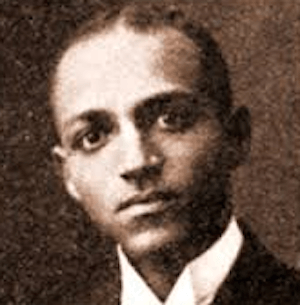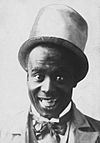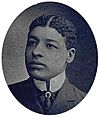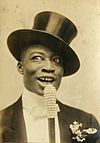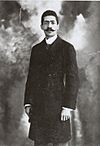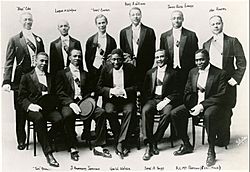Lester Walton facts for kids
Lester Aglar Walton (April 20, 1882 – October 16, 1965) was an important American figure. He was born in St. Louis, Missouri. Walton was a talented person who worked in many fields. He helped advance civil rights in journalism, entertainment, politics, and diplomacy.
The New York Times called him an "authority on Negro affairs." This means he was an expert on issues important to Black Americans. A historian named Susan Curtis said he advised U.S. presidents. She also noted he helped end housing segregation in New York City. Walton was known for many "firsts." He was America's first Black reporter for a daily newspaper. He was also the first full-time Black sportswriter. He was the first Black journalist to cover golf and early basketball.
Lester Walton was also a Broadway songwriter. He wrote songs for famous performers like Bert Williams and George Walker. He also produced his own theater shows. Walton managed the Lafayette Theatre in Harlem. He often worked with Ernest Hogan, a well-known Black comedian and performer. Some of Walton's famous songs include "Black Bohemia" and the protest song "Jim Crow Has Got to Go." This protest song was popular during early civil rights marches.
Walton was a key figure in early film criticism. He understood how powerful movies could be. He wrote a lot about how movies showed Black Americans. He argued against unfair portrayals. He also explained how movies could influence people's ideas.
Walton led a successful campaign to change how the word "Negro" was written. With help from the Associated Press, he pushed for the "N" to always be capitalized. He also worked to stop the use of the word "Negress." Later, in 1935, President Franklin Delano Roosevelt appointed him U.S. Ambassador to Liberia. He served there for over ten years. During this time, he helped create important treaties. He also helped set up an American air base. Walton also worked to help Liberia sell its rubber.
Walton's important work was recognized with three honorary degrees. In 1927, he received a Master of Arts from Lincoln University. He received law degrees (LL.D.) in 1945 from Wilberforce University and in 1958 from the University of Liberia.
Contents
Journalism Career
In 1902, Walton started working at the St. Louis Star newspaper. He was one of the first full-time Black reporters in the country. He was also the paper's first full-time Black sportswriter. He reported on golf and later became a court reporter.
By 1908, Walton joined The New York Age. This was a very important Black newspaper at the time. Few Black sportswriters worked for national papers back then. This gave Walton a strong voice. He wrote about sports, including early Black basketball in New York City. He also covered baseball and boxing.
Walton also used his writing to speak out against unfair portrayals of Black people in movies. He compared films like D.W. Griffith's 1915 Birth of a Nation to "Un-American propaganda." He argued that such films hurt democracy. He believed movies could teach people. He thought they could help white Americans understand Black communities better.
In 1913, Walton started a movement to capitalize the "N" in "Negro." He wrote to The New York Times about it. He argued that "Negro" should refer to a race of people, not just skin color. He pointed out that many Black people were not from Africa or were of mixed heritage. He believed capitalizing the word would give it more dignity.
Political and Diplomatic Work
Walton became very interested in world affairs. In 1920, he attended the Versailles Peace Conference as a reporter. Soon after, he left The New York Age. He took a full-time job with The New York World. He returned to The New York Age in 1932 as an associate editor. At the same time, he was also vice president of the Negro Actors Guild of America.
Walton was one of the first African Americans to work for the Democratic National Committee. From the mid-1920s to the early 1930s, he was active in politics. He served as director of publicity for the Colored Division of the Democratic National Committee.
By the 1930s, he became interested in Liberia. He visited the country in 1933. He wrote articles about Liberia for newspapers. In 1935, President Franklin D. Roosevelt made Walton the U.S. Ambassador to Liberia. He served there until 1946.
In Liberia, Walton achieved many things. He helped create important treaties between the U.S. and Liberia. He also helped set up a U.S. Army base there. Walton worked with the Liberian government to build a port in Monrovia. He also helped with trade and aviation agreements.
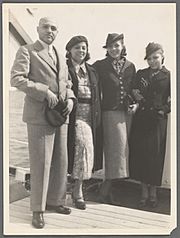
After returning to the U.S., he advised the Liberian delegation from 1948 to 1949. In 1953, Walton started the Coordinating Council of Colored Performers. This group worked to show Black characters in movies and TV in a more realistic way, not just as stereotypes.
Walton was a trusted advisor to Mayor Robert Wagner of New York City. He worked on housing and community issues in Harlem. Walton was also a founding member of Mayor Wagner’s Commission on Intergroup Relations. He played a key role in ending housing segregation in the city. In the 1960s, this agency was renamed the NYC Commission on Human Rights.
Personal Life
Lester Walton was born in 1882 in St. Louis. His father, Benjamin A. Walton, was a school custodian. His mother was Ollie May (Camphor) Walton. He graduated from Sumner High School, which was segregated at the time. After high school, his father hired a tutor to help him pass a business school exam.
At business school, he joined the Alpha Phi Alpha fraternity. This was the first college fraternity for African Americans. On June 29, 1912, Walton married Gladys Moore. Her father, Fred A. Moore, published The New York Age. Lester and Gladys had two daughters, Marjorie and Gladys Odile. Lester Walton passed away in 1965 at age 84 in Harlem.
Newspaper Affiliations
Full-time
- St. Louis Star
- The New York Age (1887–1960)
- New York World (1860–1931)
Contributing Writer or Freelancer
- The Afro-American Ledger
- St. Louis Globe Democrat
- St. Louis Post-Dispatch
Advocacy Roles
- Colored Division of the Democratic National Committee — Director of Publicity
- Commission on Intergroup Relations (later NYC Commission on Human Rights) — Original Founder and Commissioner
- Coordinating Council for Negro Performers — Founder and Chairman
- Negro Actor's Guild of America — Vice President
Professional Associations
- Elks
- American Academy of Political and Social Science
- Alpha Phi Alpha
- The Frogs (an association for Black theater professionals)
- Society of the Silurians (journalists association)


